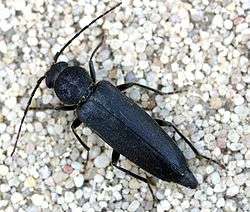Spondylidinae
Spondylidinae are a small subfamily of Cerambycidae including slightly over 100 species, primarily in the coniferous forests of the Boreal hemisphere. A few species occur in coniferous forests in tropical and subtropical areas (Mexico, Cuba), while very few genera (e.g., Zamium) are present in Austral Africa and Madagascar (e.g., Masatopus).
| Spondylidinae | |
|---|---|
 | |
| Arhopalus ferus (Mulsant, 1839) ♀ | |
| Scientific classification | |
| Kingdom: | |
| Phylum: | |
| Class: | |
| Order: | |
| Suborder: | |
| Superfamily: | |
| Family: | |
| Subfamily: | Spondylidinae |
| Tribes | |
|
see text | |
Morphology
Adult
Spondylidinae are insects characterised by cerambycine aspect, generally with a more or less flattened, dark body, oblique head and scarcely elongated antennae. Their sexual dimorphism is scarcely evident, that i,s males and females are scarcely distinguishable. Unlike Cerambycinae, their stridulitrum is divided.
Larva
The larvae are completely different from those of Cerambycinae and similar to those of Lepturinae in several respects, being characterised by a rounded head and large labrum. They also typically possess two closely spaced small spines on the last abdominal segment.
Biology
Taxonomy
History
Spondylidinae have a complicated systematic history, and details of the relationships are still uncertain. In 1897 Xambeu[2] united the genera Spondylis, Asemum, Chriocephalus (now Arhopalus) and Tetropium in Spondyliens, on the basis of the larval morphology. Nevertheless, this classification was rejected by contemporaneous authors since Spondylis was believed to be related to Prioninae and Parandra.[3] At that time most spondylidine genera were placed within the subfamily Aseminae. A later study of the wing morphology[4] confirmed Xambeu's grouping, but by the end of the 20th Century (and in some contemporaneous faunas) Spondylidini were treated as a separate subfamily. Only after 1987,[5] after further studies on the larval morphology, was it recognized that spondylidines and asemines were indeed part of the same group, rather than separate lineages. Spondylidini - whose larvae are indistinguishable from that of all other traditional Aseminae - appear to be simply highly derived Asemini, with adult morphology convergent with lucaniform Prioninae and the Vesperidae of the Amazon rainforest genus Migdolus.
Current systematics
Spondylidinae (this name has priority over Aseminae) includes five tribes.[6]
- Anisarthrini Mamaev & Danilevsky, 1973
- Asemini Thomson, 1860
- Atimiini LeConte, 1873
- Saphanini Gistel, 1856
- Spondylidini Audinet-Serville, 1832
References
- "Spondylidinae". Integrated Taxonomic Information System.
- Xambeu F., 1897-1902. Moeurs et métamorphoses des insectes, 8e Mémoire, Longicornes . L'echange (pagination spéciale) 151-209: 220 pp. + 1 Tab.
- Lameere A., 1913. Cerambycidae: Prioninae. Coleopterorum Catalogus 52, S. Schenkling, Berlin, 108 pp.
- Saalas U., 1936. Über das Flügelgeäder und die phylogenetische Entwicklung der Cerambyciden. Annales Zoologici Societatis Zoologicae-Botanicae Fennicae Vanamo 4 (1): 1-193.
- Švácha P. & Danilevsky M. L., 1987. Cerambycoid larvae of Europe and Soviet Union (Coleoptera Cerambycoidea). Part Acta Universitatis Carolinae, Biologica 30: 1-176.
- Zicha O. BioLib. Retrieved on 24 June 2015.
External links
| Wikispecies has information related to Spondylidinae |
- Check-list of World-wide Spondylidinae
- Gallery of World-wide Spondylidinae
- Gallery of American Spondylidinae
- Gallery of Japanese Spondylidinae